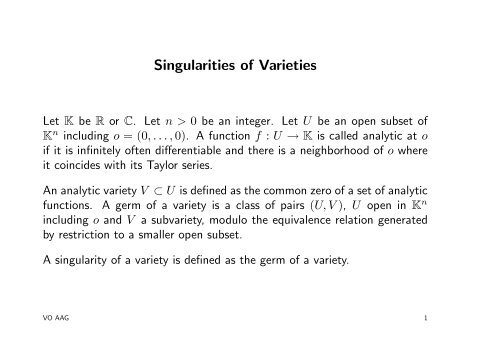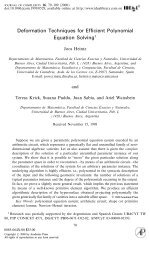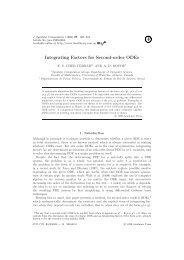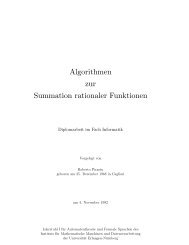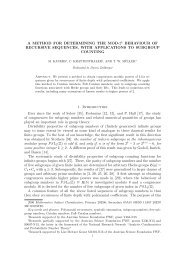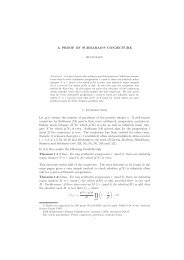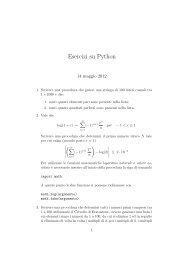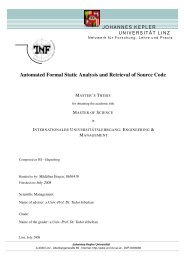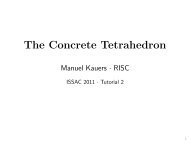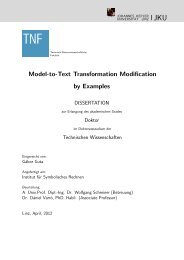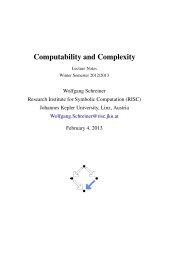Singularities of Varieties
Singularities of Varieties
Singularities of Varieties
Create successful ePaper yourself
Turn your PDF publications into a flip-book with our unique Google optimized e-Paper software.
<strong>Singularities</strong> <strong>of</strong> <strong>Varieties</strong><br />
Let K be R or C. Let n > 0 be an integer. Let U be an open subset <strong>of</strong><br />
K n including o = (0, ...,0). A function f : U → K is called analytic at o<br />
if it is infinitely <strong>of</strong>ten differentiable and there is a neighborhood <strong>of</strong> o where<br />
it coincides with its Taylor series.<br />
An analytic variety V ⊂ U is defined as the common zero <strong>of</strong> a set <strong>of</strong> analytic<br />
functions. A germ <strong>of</strong> a variety is a class <strong>of</strong> pairs (U,V ), U open in K n<br />
including o and V a subvariety, modulo the equivalence relation generated<br />
by restriction to a smaller open subset.<br />
A singularity <strong>of</strong> a variety is defined as the germ <strong>of</strong> a variety.<br />
VO AAG 1
The Vanishing Ideal<br />
Let R := K[[x 1 , ...,x n ]] be the ring <strong>of</strong> convergent power series. Let<br />
V ⊆ U ⊆ K n be a singularity. Then Ideal(V ) is defined as the ideal <strong>of</strong> all<br />
f ∈ R that vanish at all points in V . It does not depend on the choice <strong>of</strong><br />
the representative.<br />
Any ideal <strong>of</strong> R is finitely generated. Vanishing ideals are radical. The<br />
converse holds for the case K = C, but not for the case K = R.<br />
VO AAG 2
Analytic Equivalence<br />
An analytic map from a variety X to a variety Y is a function f : X → Y<br />
whose coordinates are analytic functions. Two varieties are analytically<br />
equivalent iff there are analytic maps f : X → Y and g : Y → X such that<br />
fg = id Y and gf = id X .<br />
Two singularities are analytically equivalent iff there exists an analytic<br />
isomorphism between representatives taking o to o.<br />
Two singularities V 1 and V 2 are analytically equivalent iff their quotient<br />
algebras R 1 /Ideal(V 1 ) and R 2 /Ideal(V 2 ) are isomorphic as K-algebras.<br />
VO AAG 3
Automorphisms <strong>of</strong> (K,0)<br />
A convergent power series P ∈ K[[x]], P = P 0 + P 1 x + P 2 x 2 + P 3 x 3 + . ..<br />
defines an automorphism <strong>of</strong> (K,0) iff P 0 = 0 and P 1 ≠ 0.<br />
For any power series Q ∈ K[[x]] <strong>of</strong> positive order m, Q = Q m x m +<br />
Q m+1 x m+1 +· · ·+, there is an automorphism P such that Q(P(x)) = ±x m .<br />
In case K = C, we may omit the sign.<br />
VO AAG 4
Smooth singularities<br />
A variety <strong>of</strong> dimension n is called smooth or nonsingular at some point p iff<br />
its germ at p is isomorphic to the germ <strong>of</strong> K n .<br />
The Jacobian ideal is defined as the ideal generated by all (N − n)-minors<br />
<strong>of</strong> the Jacobi matrix <strong>of</strong> a set <strong>of</strong> equations generating the vanishing ideal.<br />
(N is the number <strong>of</strong> variable, n the dimension.)<br />
Theorem. A variety is smooth at a point p iff p does not belong to the<br />
zero set <strong>of</strong> the Jacobian ideal.<br />
VO AAG 5
Reducible <strong>Singularities</strong><br />
An irreducible singularity is one which is not a union <strong>of</strong> two strictly smaller<br />
singularities.<br />
Example: The zero set <strong>of</strong> y 2 − x 2 − x 3 at the origin is the union <strong>of</strong> two<br />
smooth analytic curve germs, namely the zero set <strong>of</strong> y + x + 1 2 x2 − 1 8 x3 +<br />
1<br />
16 x4 − 5<br />
128 x5 . .. and the zero set <strong>of</strong> y − x − 1 2 x2 + 1 8 x3 − 1 16 x4 + 5<br />
128 x5 ... .<br />
VO AAG 6
Plane Curve <strong>Singularities</strong><br />
A plane curve singularity is given by a squarefree power series F(x,y)<br />
vanishing at o. The order <strong>of</strong> F is invariant under analytic isomorphisms.<br />
The singularity is smooth iff ord(F) = 1.<br />
If a plane curve singularity is reducible, then its order is equal to the sum <strong>of</strong><br />
orders <strong>of</strong> the components.<br />
VO AAG 7
Weierstraß Preparation<br />
Theorem. Any plane curve singularity <strong>of</strong> order n is isomorphic to one<br />
defined by an equation F ∈ K[[x]][y] (i.e. F is polynomial in y) such that<br />
deg y (F) = n and coeff y n(F) = 1.<br />
Sketch <strong>of</strong> Pro<strong>of</strong>. First, we apply an isomorphism to transform the equation<br />
F 0 <strong>of</strong> order n to another equation F 1 which is regular in y. This means<br />
that if we write F 1 as power series in y with coefficients in K[[x]], then the<br />
constant term <strong>of</strong> coeff y n(F 1 ) is not zero. This can be achieved by a linear<br />
map (x, y) ↦→ (x + αy, y) for suitable α ∈ K.<br />
Second, we write y n as F 1 Q + R with Q ∈ K[[x,y]] and R ∈ K[[x]][y],<br />
deg y (R) < n, using power series division. Then y n − R and F 1 generate<br />
the same ideal in K[[x,y]], hence y n − R is an equation as required.<br />
VO AAG 8
Exercise<br />
Prove that every double point is analytically equivalent to y 2 − x n for some<br />
n ≥ 2.<br />
VO AAG 9
Classification <strong>of</strong> Plane Double Points<br />
How can we prove that y 2 − x n and y 2 − x m are not equivalent, for<br />
2 ≤ m < n?<br />
VO AAG 10
Generalizations<br />
A hypersurface singularity in K d is given by a squarefree power series in<br />
K[[x 1 ,...,x d ]].<br />
A hypersurface singularity is smooth iff its order is 1.<br />
The order <strong>of</strong> a reducible hypersurface singularity is equal to the sum <strong>of</strong> the<br />
orders <strong>of</strong> the components.<br />
Any hypesurface singularity <strong>of</strong> order n is isomorphic to one defined by<br />
an equation F ∈ K[[x 1 , ...,x d−1 ]][x d ] such that that deg xd<br />
(F) = n and<br />
coeff xd n(F) = 1.<br />
VO AAG 11
Generalizations<br />
The Hessian <strong>of</strong> F is the symmetric d × d matrix <strong>of</strong> all second derivatives.<br />
The rank <strong>of</strong> the Hessian and, in the real case, the absolute value <strong>of</strong><br />
the index (number <strong>of</strong> positive minus number <strong>of</strong> negative eigenvalues) are<br />
analytic invariants.<br />
Let F be the equation <strong>of</strong> a hypersurface singularity in K d such that the rank<br />
<strong>of</strong> the Hessian is equal to r and the number <strong>of</strong> positive eigenvalues is s ≤ r/2<br />
(without loss <strong>of</strong> generality, otherwise we multiply the equation by −1). Then<br />
F is analytically equivalent to x 2 1 + · · · + x 2 s − x 2 s+1 − x 2 r + G(x r+1 , ...,x d )<br />
for some G ∈ K[[x r+1 ,...,x d ]].<br />
This decomposition is unique in the sense that r and s and the analytic<br />
equivalence class <strong>of</strong> G as a singularity in K d−r are uniquely determined.<br />
VO AAG 12
Deciding Equivalence<br />
Given two squarefree power series F and F 1 , how can we decide whether<br />
the singularities <strong>of</strong> F and F 1 are equivalent?<br />
We will show that this can be decided by an algorithm who looks only at<br />
finitely many coefficients <strong>of</strong> F and F 1 .<br />
It follows that every plane curve singularity can be represented by a<br />
polynomial.<br />
VO AAG 13
Tougeron Theory<br />
Let F, G be two power series <strong>of</strong> order at least 3. We say “G is close to F”<br />
iff G − F is in J(F) 2 , the square <strong>of</strong> the Jacobian ideal.<br />
Lemma. If G is close to F, then J(F) = J(G).<br />
It follows that “close to” is an equivalence relation.<br />
VO AAG 14
Tougerons Theorem<br />
Theorem. If G is close to F, then G and F are analytically equivalent.<br />
Pro<strong>of</strong>. Given G close to F, we define an analytic isomorphism U :<br />
(x, y) ↦→ (x + S(x,y), y + T(x,y)) such that F is close to F ◦ U and<br />
ord(F ◦ U − G) > ord(F − G). Then we show that the composition <strong>of</strong><br />
these isomorphisms converges.<br />
VO AAG 15
Finite Determinacy<br />
Theorem. There exists an integer n, depending on F, such that J(F) 2<br />
contains all power series <strong>of</strong> order greater than n.<br />
Pro<strong>of</strong>. Assume, indirectly, that ∂ x F and ∂ y F have a common irreducible<br />
factor G. Then F is constant in the zero set <strong>of</strong> G, hence G divides F,<br />
F = GH for some H, and G divides G x H, hence F is not squarefree.<br />
This shows that the zero set <strong>of</strong> J(F) is just the point o. By Hilberts<br />
Nullstellensatz, the radical <strong>of</strong> J(F) is equal to 〈x, y〉. Hence there exists<br />
m such that x m ∈ J(F) and y m ∈ J(F). It follows that any monomial <strong>of</strong><br />
order at least n = 3m − 1 is in J(F) 2 .<br />
VO AAG 16
Exercise<br />
Determine N such that x 3 + y 3 is equivalent to x 3 + y 3 + G(x, y) for any<br />
G <strong>of</strong> order greater than n.<br />
VO AAG 17
Deformations<br />
A deformation <strong>of</strong> a plane curve singularity F(x, y) is a germ <strong>of</strong> an analytic<br />
function G(x, y, ǫ) such that G(x, y, 0) = F(x,y).<br />
Theorem. The order <strong>of</strong> a singularity does not increase in a deformation.<br />
Problem. Which isomorphism classes arise in a deformation <strong>of</strong> a fixed<br />
singularity? Solve this problem for F(x,y) = y 2 − x n .<br />
VO AAG 18
Group Actions<br />
A Lie group is a nonsingular variety (manifold) such that the multiplication<br />
and the inverse are analytic functions.<br />
An (left) action <strong>of</strong> a Lie group G on a manifold M is an analytic function<br />
G × M → M, (g,m) ↦→ g.m, such that (gh).m = g.(h.m).<br />
The group action induces an equivalence relation on M. The equivalence<br />
classes are called orbits.<br />
VO AAG 19
Group Actions<br />
Theorem. Let N ⊆ N be a submanifold. Let p ∈ N. If the tangents<br />
space <strong>of</strong> N and the image <strong>of</strong> the tangent space <strong>of</strong> G under the differential<br />
<strong>of</strong> the map G → M, g ↦→ g.p, generate the tangent space <strong>of</strong> M, then N<br />
intersects every orbit in a neighborhood <strong>of</strong> p.<br />
VO AAG 20
Application<br />
Let F(x, y) be a polynomial, and let n be an integer such that F(x,y) +<br />
G(x, y) ≡ F(x, y) for any G or order greater than n. We consider the group<br />
G 1 × G 2 , where G 1 is the group <strong>of</strong> all analytic isomorphisms truncated at<br />
order n, and G 2 is the group <strong>of</strong> all units in the power series ring, truncated<br />
at order n. The set M is the set <strong>of</strong> all power series truncated at order n,<br />
G 1 acts by substitution and G 2 by multiplication.<br />
VO AAG 21
Examples<br />
F(x, y) = x 3 + y 3 ,<br />
M = {x 3 + y 3 + a ij x i y j | 1 ≤ i + j ≤ 5,a ij ∈ K},<br />
TM = {a ij x i y j | 1 ≤ i + j ≤ 5},<br />
G 1 = {(u ij x i y j ,v ij x i y j ) | 1 ≤ i + j ≤ 5,u 10 v 01 − u 01 v 10 ≠ 0} ,<br />
TG 1 = {(u ij x i y j , v ij x i y j ) | 1 ≤ i + j ≤ 5} ,<br />
G 2 = {w ij x i y j | 0 ≤ i+j ≤ 5, w 00 ≠ 0}, TG 2 = {w ij x i y j | 0 ≤ i+j ≤ 5},<br />
(TG 1 × TG 2 ) → TM, (U,V,W) ↦→ 3x 2 U + 3y 2 V + (x 3 + y 3 )W<br />
The image <strong>of</strong> the map is the ideal generated by δ x F,δ y F,F. Any vectorspace<br />
in TM that contains representatives for all residue classes satisfies the<br />
assumption <strong>of</strong> the theorem.<br />
VO AAG 22
Problems<br />
Which isomorphism classes arise in deformations <strong>of</strong> x 3 + y 3 ?<br />
Same question for x 2 y + y 4 , x 3 + y 4 , x 3 + y 5 , x 3 + y 6 .<br />
VO AAG 23
Higher Dimensional Analogues<br />
Tougeron’s theorem is valid in any dimension.<br />
What fails to hold is finite determinacy. There exists no N such that for all<br />
F ∈ K[[x, y, z]] <strong>of</strong> order larger than N, x 2 +y 2 +F is equivalent to x 2 +y 2 .<br />
Finite determinacy does hold for isolated singularities.<br />
VO AAG 24
<strong>Singularities</strong> <strong>of</strong> Maps<br />
Let M, N be real differential manifolds (maybe with boundary). The set<br />
D(M,N) <strong>of</strong> differentiable functions admits several topologies. We can work<br />
with any topology such that the Taylor expansion at any point is continuous.<br />
Let us write D ∗ (M) for the set <strong>of</strong> all diffeomorphisms from M to itself.<br />
Then D ∗ (M) × D ∗ (N) acts on D(M, N) by (u,v).f = vfu −1 .<br />
VO AAG 25
Stable Maps<br />
A map f : M → N is stable iff its orbit under the action above is open in<br />
D(M,N). This means that any sufficiently close map is equivalent to it.<br />
Example. M = N = [−1,1]. Characterize all stable maps.<br />
In this example, the stable maps are dense, i.e. any map can be deformed<br />
to a stable map.<br />
VO AAG 26
Morse Lemma<br />
Assume N = R. Then f is stable iff the Hessian is nondegenerate at all<br />
critical points, and the function values <strong>of</strong> the critical points ar all different.<br />
Moreover, the set <strong>of</strong> stable functions is dense.<br />
VO AAG 27
Local Stability<br />
A map germ f : (R m ,0) → (R n ,0) is stable iff for any deformation g <strong>of</strong> f<br />
there is a point p in the neighborhood <strong>of</strong> 0 such that the germ <strong>of</strong> g at p is<br />
equivalent to f.<br />
If f is stable, then all germs <strong>of</strong> f are locally stable. The converse is not<br />
true (e.g. extra condition on values to be distinct).<br />
VO AAG 28
Infinitesimal Stability<br />
Let D m,n be the set <strong>of</strong> germs <strong>of</strong> differentiable functions f : (R m , 0) →<br />
(R n , 0). Let G m be the group <strong>of</strong> germs <strong>of</strong> automorphisms <strong>of</strong> (R m ,0).<br />
Obviously G m × G n acts on D m,n but this is not enough.<br />
Take f ∈ D m,n represented by a function defined on U ⊂ R m . For any<br />
x 0 ∈ U, x → (f(x + x 0 ) − f(x 0 )) is also in D m,n . For fixed U, this defines<br />
an action, and the derivative <strong>of</strong> this action at 0 does not depend on the<br />
choice <strong>of</strong> U.<br />
We say that f is infinitesimally stable iff the differential <strong>of</strong> the action above<br />
(isomorphism and translation together) is surjective.<br />
VO AAG 29
Example<br />
m = n = 1. We may assume that f(x) = x d for some d > 0. Then<br />
the image <strong>of</strong> the differential <strong>of</strong> right equivalence together with translation<br />
is the ideal generated by f ′ (x), which is the vectorspace generated by x a ,<br />
a ≥ d − 1. The ideal generated by left equivalence is the vectorspace<br />
generated by x b , d | b.<br />
It follows that x d is stable iff d = 1 or d = 2.<br />
VO AAG 30
Algebraic Criterion<br />
f ∈ D m,n is infinitesimally stable iff the the quotient <strong>of</strong> R[[x 1 ,...,x m ]] n<br />
by the module generated by the partial derivatives and by f i e j , where f i is<br />
the i-th coordinate <strong>of</strong> f and e j is the j-th unit vector, is generated by the<br />
unit vectors over R.<br />
Example (x, y) ↦→ (x 3 + xy, y).<br />
VO AAG 31
Whitneys Theorem<br />
Assume m = n = 2. Then f is locally stable iff f is nonsingular, or f is<br />
isomrphic to (x,y) ↦→ (x 2 ,y) (a fold), or (x, y) ↦→ (x 3 + xy, y) (a pleat).<br />
Assume dim(M) = dim(N) = 2 and M is compact. Then f is stable iff it<br />
is locally stable at any point, and the set <strong>of</strong> critical values in N is a curve<br />
with only ordinary nodes and cusps. The set <strong>of</strong> stable maps is dense.<br />
VO AAG 32
Other Cases<br />
m = 1, n = 2: locally stable iff nonsingular, stable iff image has only<br />
ordinary double points.<br />
m = 1,n > 2: stable iff immersion as a submanifold<br />
n = 1: Morse theorem.<br />
m = 2, n = 3: locally stable iff nonsingular or (x, y) ↦→ (xy, y, x 2 ). Stable<br />
iff image has local equation x = 0 or xy = 0 or xyz = 0 or x 2 − y 2 z = 0.<br />
m = n ≥ 9: stable maps are not dense!<br />
VO AAG 33
Blowing Up<br />
The blowup <strong>of</strong> the plane C 2 is an algebraic map p : Y → C 2 , where Y is a<br />
manifold that can be covered by two open subsets isomorphic to C 2 . It has<br />
the following properties:<br />
p −1 (o) is a curve E ⊂ Y. Apart from that, p restricts to an isomorphism<br />
Y − E → C 2 − {o}. The points <strong>of</strong> E correspond to tangent directions at o.<br />
Any automorphism <strong>of</strong> C 2 that fixes o lifts to an automorphism <strong>of</strong> Y<br />
preserving E. Even more, any analytic automorphism <strong>of</strong> the germ <strong>of</strong> C 2 at<br />
o lifts to a local automorphism <strong>of</strong> a neighborhood <strong>of</strong> E in Y fixing E.<br />
VO AAG 34
Total transform and proper transform<br />
If C ⊂ C 2 is a curve containing o, then p −1 (C) has two components: the<br />
proper transform ˜C and the exceptional curve E. The pullback <strong>of</strong> the<br />
equation F <strong>of</strong> C factors into x m ˜f(x, ỹ), where ˜f is the local equation <strong>of</strong><br />
˜C, x is the equation <strong>of</strong> the exceptional curve, and m is the order <strong>of</strong> C at o.<br />
The curve ˜C may have “new” singular points in E. The sum <strong>of</strong> all orders<br />
at these new points is less than or equal to m.<br />
Theorem. The procedure <strong>of</strong> blowing up singular points is finite.<br />
VO AAG 35
Invariants and blowing up<br />
The curve C is irreducible iff all proper transforms intersect E in only one<br />
point.<br />
For any plane curve singularity, the Milnor number µ is defined as the<br />
intersection multiplicity <strong>of</strong> the two partial derivatives, and the δ-invariant is<br />
defined as the height <strong>of</strong> the integral closure.<br />
Assume that P 1 ,...,P k are the singularities <strong>of</strong> the proper transform lying<br />
on E. Then the formulas hold<br />
µ = m(m − 1) + µ 1 + · · · + µ k − k + 1<br />
δ = m(m − 1)/2 + δ 1 + · · · + δ k<br />
VO AAG 36
Point Blowups in Higher Dimension<br />
The blowup <strong>of</strong> a point in C n is an algebraic map p : Y → C n , where Y is a<br />
manifold that can be covered by n open subsets isomorphic to C n . It has<br />
the following properties:<br />
p −1 (o) is a hypersurface E ⊂ Y. Apart from that, p restricts to an<br />
isomorphism Y − E → C n − {o}. The points <strong>of</strong> E correspond to tangent<br />
directions at o.<br />
VO AAG 37
Blowup <strong>of</strong> Submanifolds<br />
Let o ∈ C n . Then the blowup the submanifold L = {o} × C m ⊂ C n+m is<br />
just the direct product <strong>of</strong> the blowup <strong>of</strong> C n at o with C m . It can be covered<br />
by n open subsets isomorphic to C n × C m . The exceptional hypersurface is<br />
p −1 (L).<br />
Example: blowup x = y = 0 in C 3 .<br />
VO AAG 38
Transversality<br />
Assume H : x = 0 is an exceptional divisor in C 3 . We blow up the curve<br />
C : y = x + z 2 = 0.<br />
Step 1: Coordinate transformation making the curve into a line (x is<br />
replaced by x − z 2 ):<br />
H : x − z 2 = 0, C : y = x = 0.<br />
Step 2: First chart <strong>of</strong> blowup: x is replaced by xy.<br />
exceptional divisor becomes singular.<br />
Then the “old”<br />
VO AAG 39
Transversality<br />
Better: only blowup centers which intersect all old exceptional hypersurfaces<br />
transversally. This means: for any point, there is an analytic coordinate<br />
system such that the center is defined by coordinates AND all exceptional<br />
hypersurfaces are defined by coordinates.<br />
VO AAG 40
Variants <strong>of</strong> Resolution<br />
Resolution <strong>of</strong> varieties: sequence <strong>of</strong> blowups such that the proper transform<br />
is nonsingular.<br />
Resolution <strong>of</strong> functions: sequence <strong>of</strong> blowups such that the pullback can<br />
locally be defined by products <strong>of</strong> coordinates (monomials).<br />
Resolution <strong>of</strong> ideals: sequence <strong>of</strong> blowups such that the pullback is locally<br />
generated by such a monomial.<br />
Resolution <strong>of</strong> hypersurfaces can be reduced to resolution <strong>of</strong> functions.<br />
Resolution <strong>of</strong> varieties and resolution <strong>of</strong> functions can be reduced to<br />
resolution <strong>of</strong> ideals.<br />
VO AAG 41
Controlled Ideals, Singular Locus, Controlled Transform<br />
A controlled ideal is an ideal together with a positive integer.<br />
The singular locus <strong>of</strong> a controlled ideal (I,c) is the set <strong>of</strong> all points where<br />
the ideal has order at least c.<br />
If the center is contained in the singular locus, then the controlled transform<br />
is defined by dividing out the c-th power <strong>of</strong> the exceptional ideal.<br />
Resolution <strong>of</strong> controlled ideals: sequence <strong>of</strong> blowups with center in the<br />
singular locus, such that the singular locus is empty.<br />
VO AAG 42
Reduction Problems<br />
Can you reduce the resolution problem <strong>of</strong> ideals to the resolution problem<br />
<strong>of</strong> controlled ideals?<br />
Conversely?<br />
A controlled ideal is called tight iff its order is never greater then c. Can you<br />
reduce the resolution problem <strong>of</strong> controlled ideals to the resolution problem<br />
<strong>of</strong> tight controlled ideals?<br />
VO AAG 43
Sum <strong>of</strong> Controlled Ideals<br />
Let (I 1 ,c 1 ) and (I 2 ,c 2 ) be two controlled ideals. Then the sum is defined<br />
as (I 3 , c 1 c 2 ), where I 3 = I c 2<br />
1 · Ic 1<br />
2 . This operation is commutative and<br />
associative.<br />
Proposition. The singular set <strong>of</strong> the sum is equal to the intersection. Sum<br />
commutes with controlled transform.<br />
VO AAG 44
Rees Algebras<br />
Let R be the function ring <strong>of</strong> an algebraic or analytic variety (for instance,<br />
R = C[x 1 , ...,x n ]). A Rees algebra over R is a graded ring A = ⊕ ∞ i=0 A i,<br />
such that R = A 0 ⊇ A 1 ⊇ A 2 ⊇ . ...<br />
The Rees algebra is finitely generated iff there exists b such that A is<br />
generated by all elements <strong>of</strong> degree at most b.<br />
The singular set <strong>of</strong> a Rees algebra is the set <strong>of</strong> all points where A i has order<br />
at least i.<br />
Consider a blowup at a center in the singular locus. Then the proper<br />
transform <strong>of</strong> the Rees algebra is defined as the Rees algebra generated by<br />
the controlled transforms <strong>of</strong> (A i ,i) in degree i.<br />
VO AAG 45
Translation Controlled Ideals - Rees Algebras<br />
Let (I,c) be a controlled ideal. Then the Rees algebra A(I,C) is defined<br />
as the one generated by I in degree c.<br />
Conversely, let A be a Rees algebra which is generated in degree at most b.<br />
Then the associated controlled ideal is defined as the sum <strong>of</strong> the controlled<br />
ideals (A i ,i), i = 1,...,b.<br />
VO AAG 46


